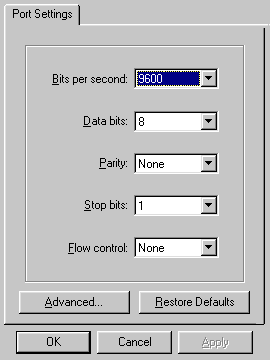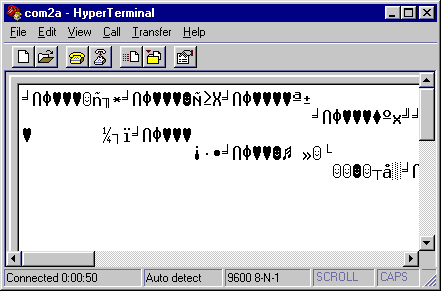Introduction
Over the past few days I've been having some major problems getting my Palm V to hotsync with my Win98 machine, so I thought I would document the different ways I tested my system to diagnose the problem.
First of all, I upgraded my computer relatively recently (5 months ago) with a new Tyan motherboard (Celeron 500 MHz) with two built-in COM ports. When it came to hotsyncing my Palm V, I seemed to have problems using the COM1 serial port. Since I had numerous PCI cards installed, I assumed the problem was a conflicting IRQ (Interrupt) setting so I used COM2 with no problems. I noticed two days ago that my Palm V couldn't connect with my Win98 machine using either COM1 or COM2! What's going on? Did the "I LOVE YOU" virus corrupt some Windows files or my Hotsync app? Did my COM ports short out? Is my Hotsync cradle on the blink?
Investigation Strategy
I reasoned
that the problem may be one of the following things:
- The Hotsync software on Win98 machine is corrupt and needs to be reloaded.
- The Palm V is having OS problems and needs to be reset.
- The COM ports on my motherboard are somehow conflicting with other components in my Win98 system.
- The COM ports are no longer functional.
- The Hotsync cradle is damaged.
- Some software setting (either on my Palm V and/or Hotsync software) is screwed up.
Detective
Work
First, I tried downloading the lastest Hotsync software from the www.palm.com site and re-installed it on my Win98 machine. I checked the Hotsync settings and tried a Hotsync with my Palm V in the cradle.... nothing.
Next, I did a soft reset on my Palm V and tried to Hotsync... nothing. Then, I did a hard reset on my Palm V (wiping out everything) and did another Hotsync.... again, nothing.
Now I'm suspecting the COM ports having conflicting IRQs with the other boards in my Win98 system. I then remove all the various boards (e.g., Modem card, network card, SCSI card, Sound card) leaving only the Video Board connected to the monitor. I tried another Hotsync with no success. At this point, I was pretty sure I didn't have any conflicting IRQs... if you are not too sure, you can check out Palm's web site for more info on COM ports and IRQ conflicts.
Next, I rebooted my machine and initiated the BIOS setup during bootup to check for any accidental disabling of the COM ports. Nope, both serial ports are enabled. As a suggestion from the Tyan Technical Support, I reset the CMOS settings and then rebooted the machine. Still no Hotsync.
Thinking this might be a Windows settings problem, I decided to use the PenguinBackup boot disk to startup my PC using Linux and test both COM ports. To do this, I put in my PenguinBackup disk in my floppy drive and rebooted my system. After a few minutes, Linux loaded up and the PenguinBackup program was running. I then selected "Basic Configuration" and picked COM1 as the Hotsync port, and continued through to the "Testing port" menu. From here, I selected "Yes" to begin testing of the port and hit the Hotsync button on my Cradle. Nothing happened. I got the same results for COM2. From this, it seemed that both COM ports were not working at all!
As a check, I used the PenguinBackup boot disk on my laptop machine and did the same test. Both COM ports worked fine, and were able to read the data on the Palm V device! So it's looking more and more like bad COM ports on my Win98 motherboard.
As another
test, I did the following to see if any data was being successfully transmitted
from the Palm V through the Hotsync cradle and through the COM port:
- 1) Connect
the Hotsync cradle to COM2 and place the Palm V in the cradle.
- 2) Startup the Win98 application
called "Hyperterminal" and set the data port and settings as illustrated
in Figures 1 & 2.

Figure 1
|

Figure 2
|
- 3) Next, press the Hotsync button
on the Cradle. Data should now be streaming from the cradle through
the COM2 port and onto Hyperterminal's display screen as show in Figure
3. If you don't see anything, then chances are good that either your
cradle or COM port is not working correctly. If you do see garbage
text scrolling across the Hyperterminal display, then you know the COM
port and Hotsync cradle are probably working fine.

Figure 3
Data coming
from Palm V Hotsyncing
Conclusions
From these tests, I've concluded that the problem was non-functional COM ports. Using the Linux boot disk and PenguinBackup app is what convinced me that it wasn't a Windows OS or Hotsync application problem, but rather a hardware problem. Fortunately, my Tyan motherboard is still covered under Tyan's 3-year warranty so the COM ports should be fixed without much additional cost.
[update
5-25-00] ![]() -
Tyan decided to replace my old motherboard with a new one, and both COM
ports test out ok using the Penguin backup test utility! Usually
these COM problems are a result of conflicting IRQs, but in some cases
it's just bad hardware!
-
Tyan decided to replace my old motherboard with a new one, and both COM
ports test out ok using the Penguin backup test utility! Usually
these COM problems are a result of conflicting IRQs, but in some cases
it's just bad hardware!